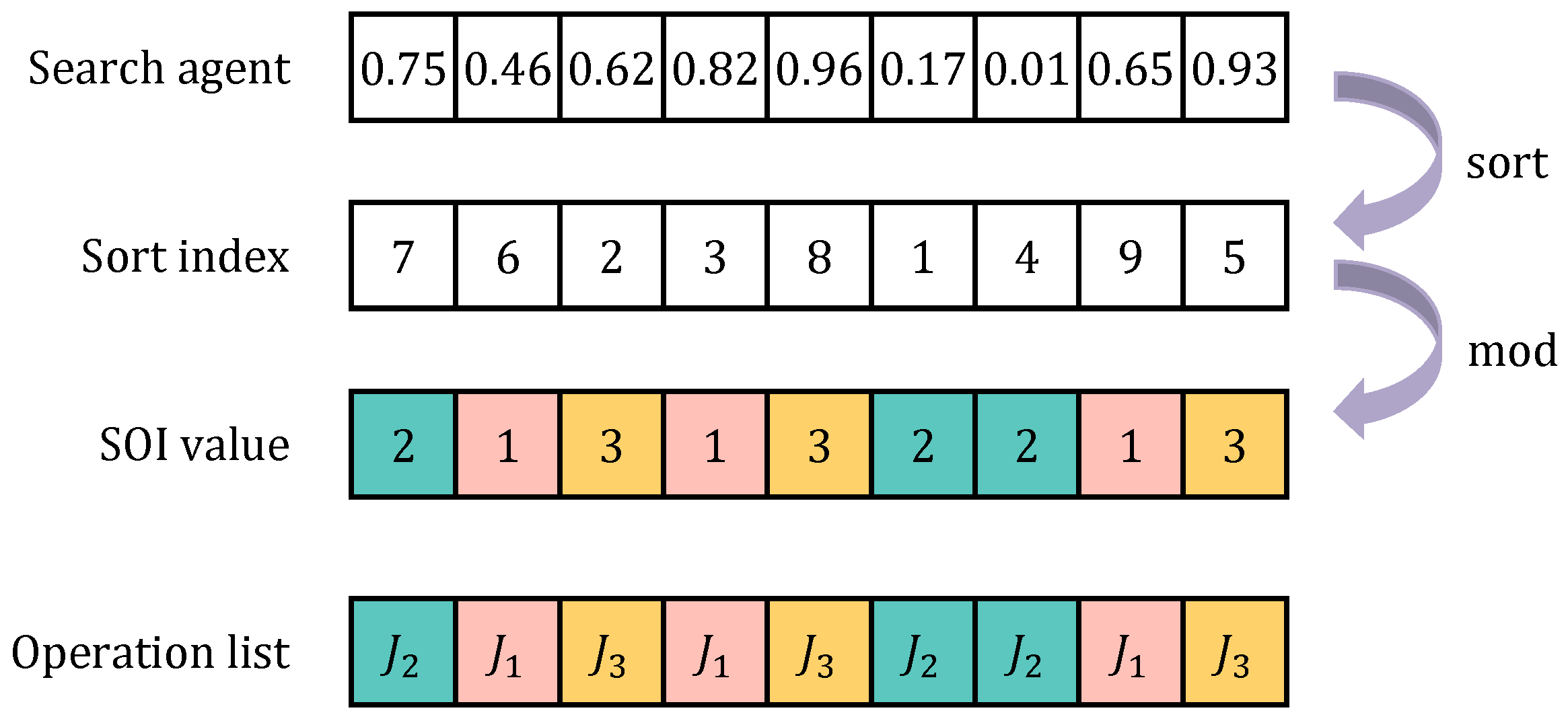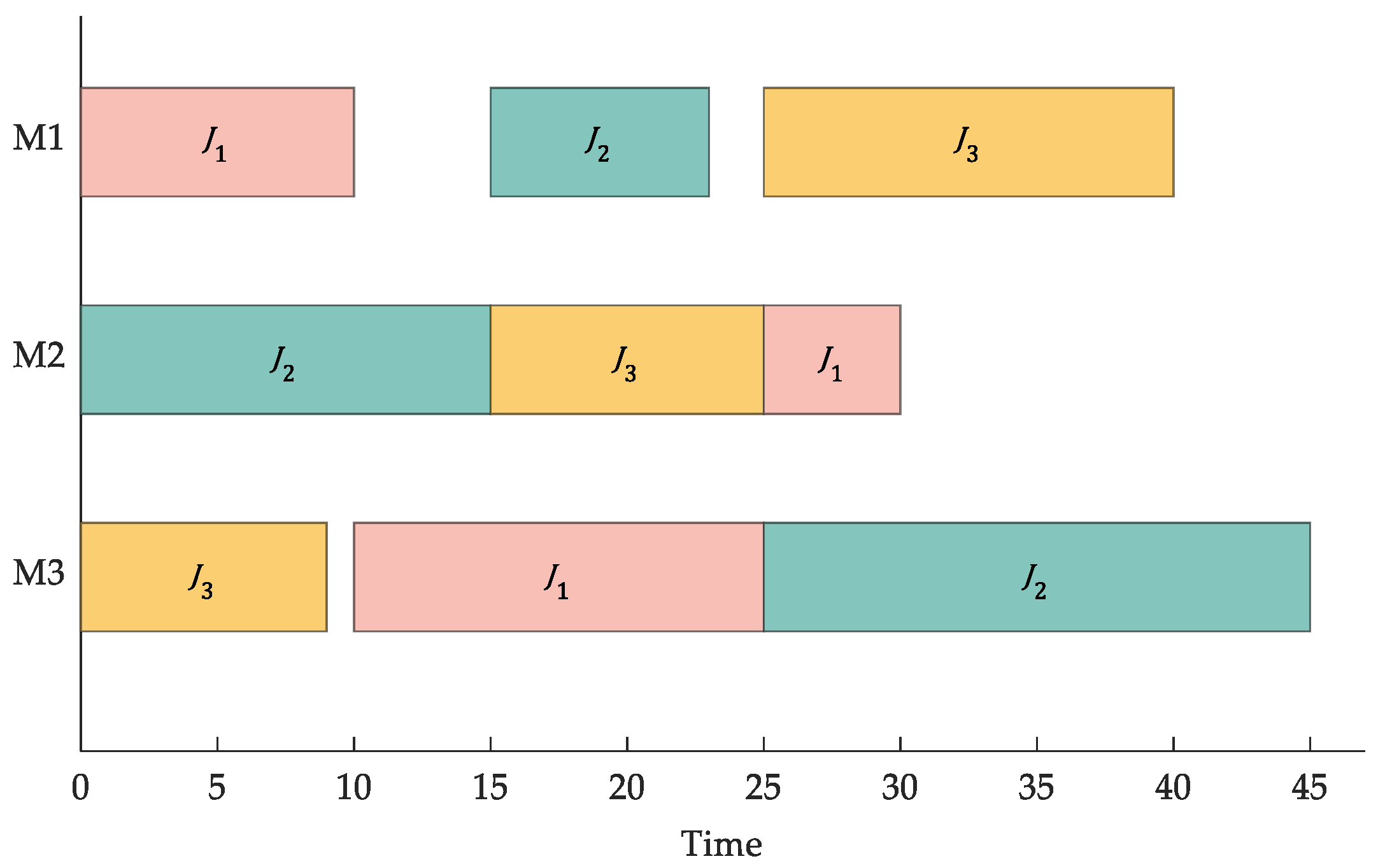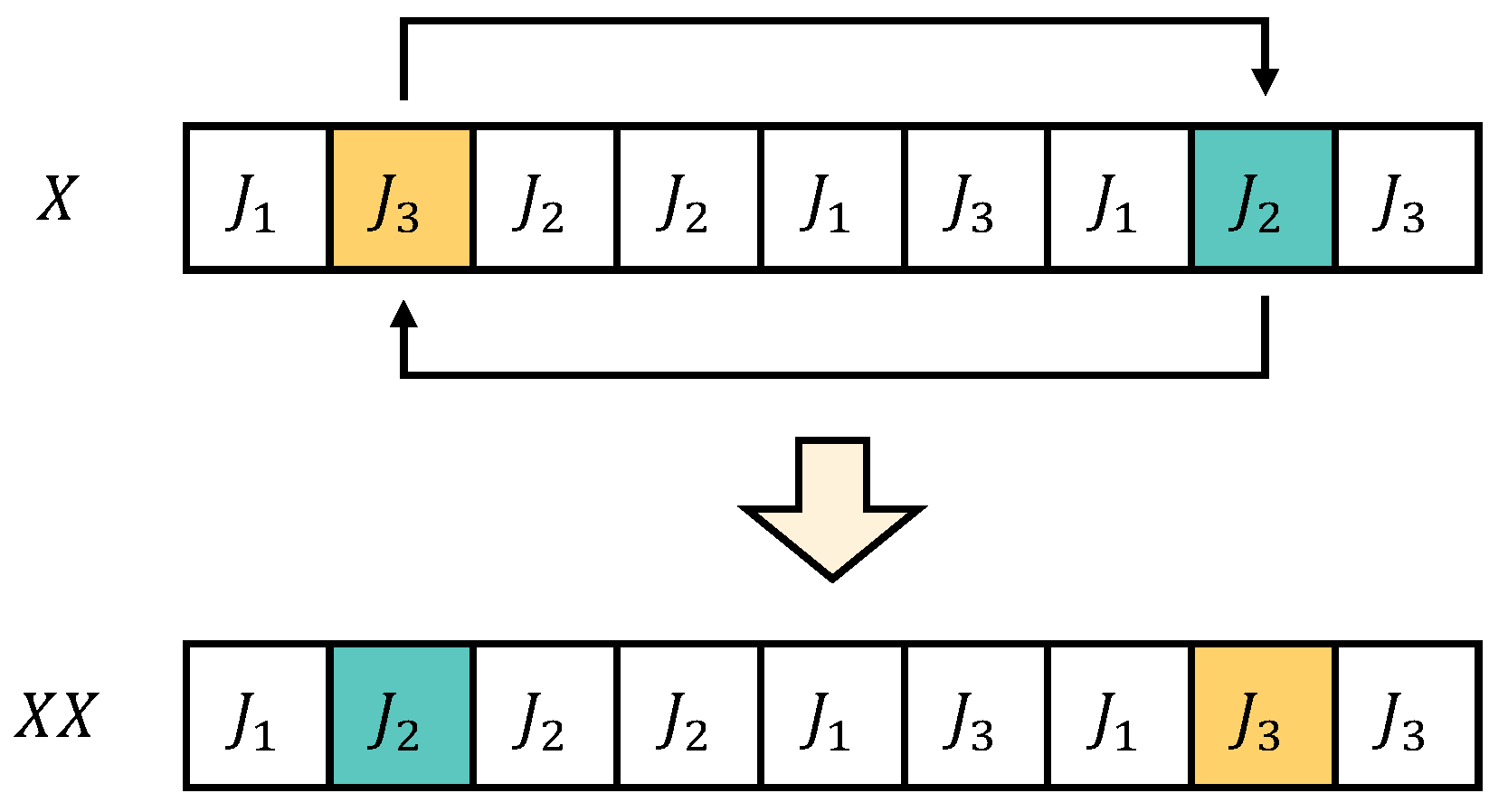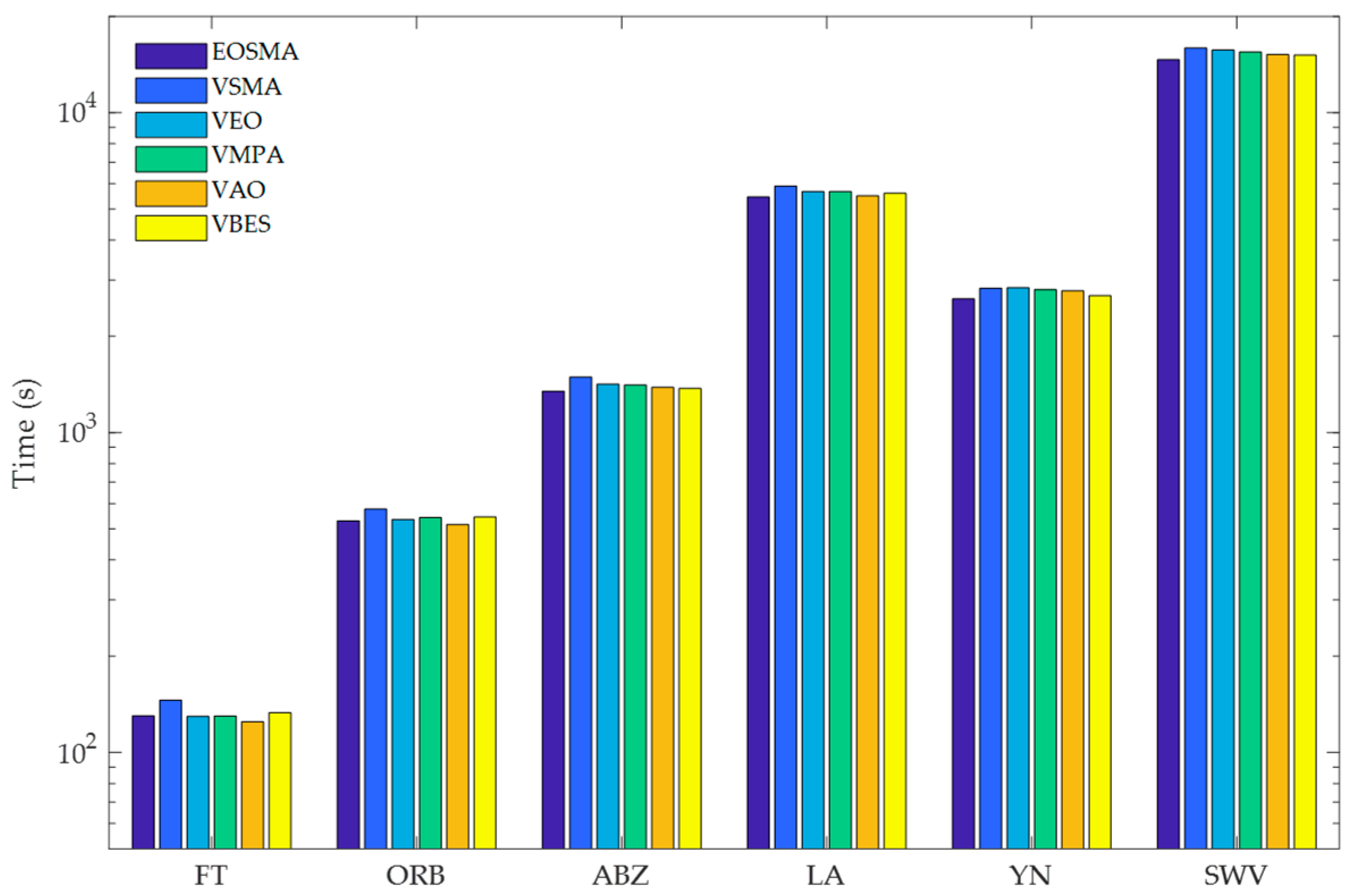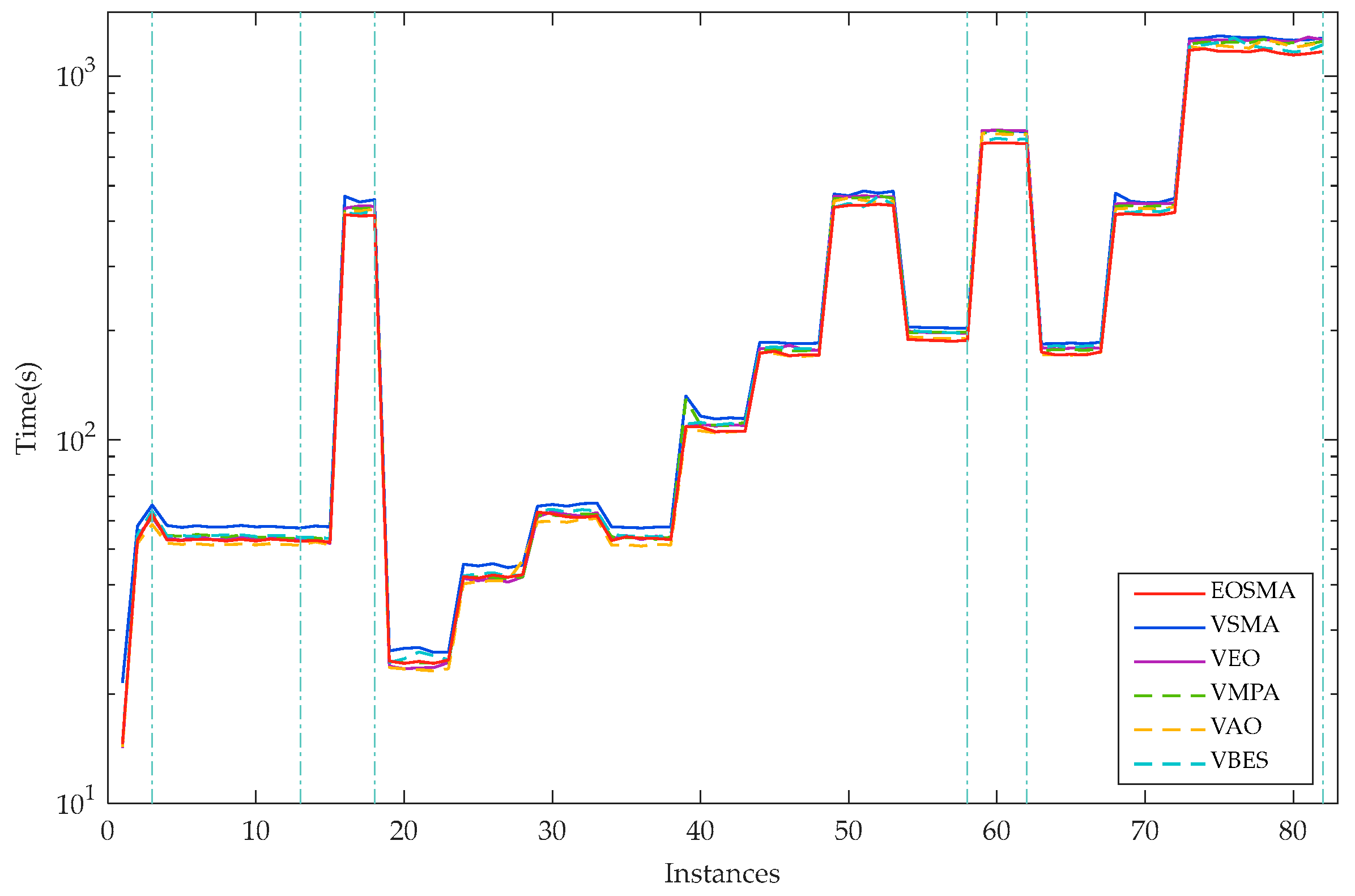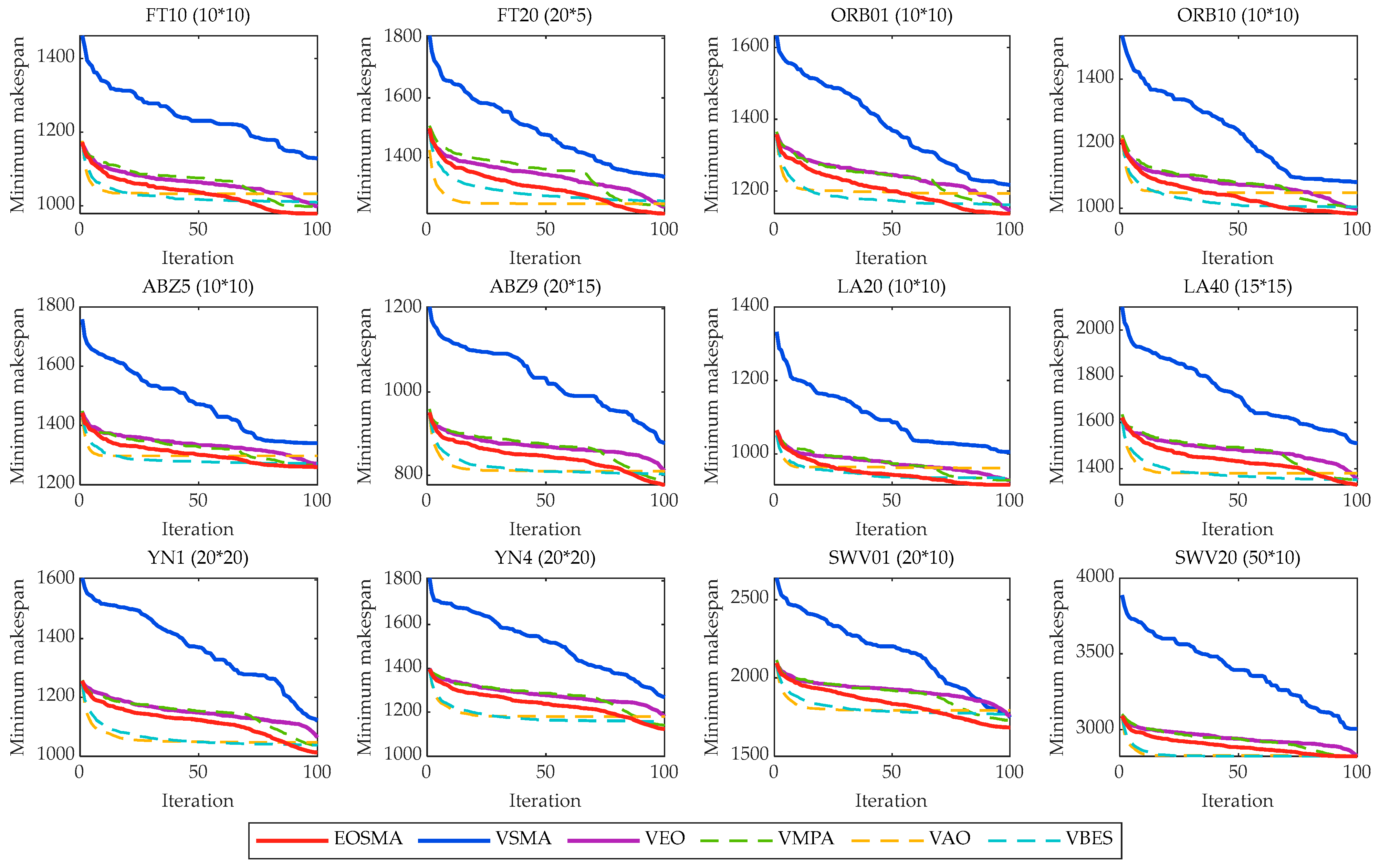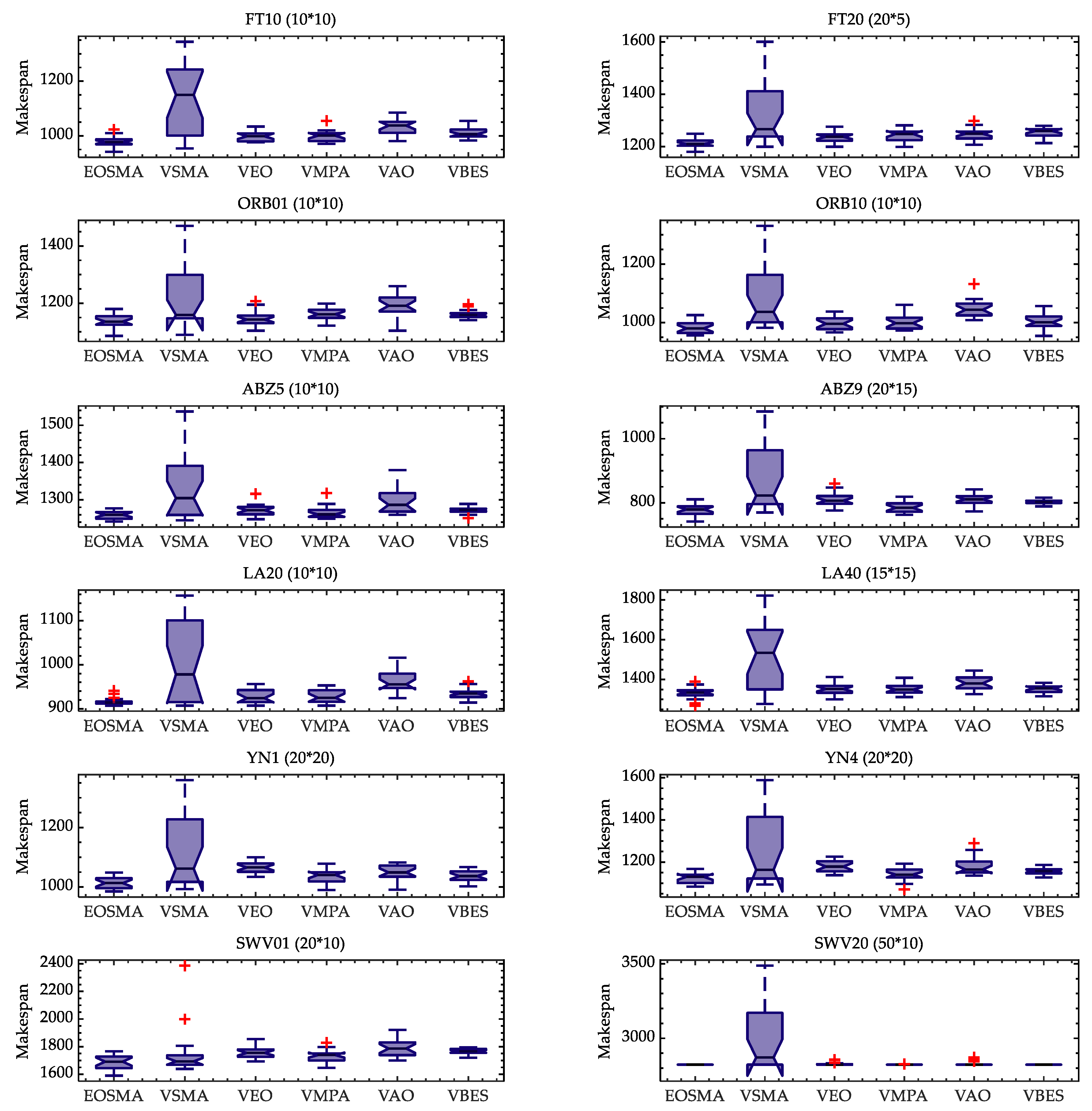1. Introduction
Job Shop Scheduling Problem (JSSP) has become a hot topic in the manufacturing industry; a reasonable JSSP solution can effectively help manufacturers improve productivity and reduce production costs. However, JSSP has been proved to be an NP-hard problem, which is among the most difficult problems to solve [
1]. This means that even medium-sized JSSP instances cannot be guaranteed to obtain an optimal solution in finite time with exact solution methods [
2]. Therefore, many researchers have turned their attention to metaheuristic algorithms. According to the algorithmic principle, metaheuristic algorithms may be categorized into three categories: evolution-based, physics-based, and swarm-based [
3]. The Genetic Algorithm (GA) [
4] and Differential Evolution (DE) [
5] are the two primary evolution-based algorithms that have been developed to simulate Darwinian biological evolution. The most common physics-based algorithms include Simulated Annealing (SA) [
6], Gravitational Search Algorithm (GSA) [
7], Multi-verse Optimizer (MVO) [
8], Atom Search Optimization (ASO) [
9], and Equilibrium Optimizer (EO) [
10]; all are inspired by the principles of physics. Swarm-based algorithms mainly simulate the cooperative properties of natural biological communities. Typical algorithms include Particle Swarm Optimization (PSO) [
11], Artificial Bee Colony (ABC) [
12], Social Spider Optimization (SSO) [
13], Gray Wolf Optimizer (GWO) [
14], Whale Optimization Algorithm (WOA) [
15], Seagull Optimization Algorithm (SOA) [
16], Salp Swarm Algorithm (SSA) [
17], Harris Hawks Optimization (HHO) [
18], Teaching Learning-based Optimization (TLBO) [
19], Aquila Optimizer (AO) [
20], Bald Eagle Search (BES) [
21], Slime Mould Algorithm (SMA) [
22], Marine Predators Algorithm (MPA) [
23], Chameleon Swarm Algorithm (CSA) [
24], Adolescent Identity Search Algorithm (AISA) [
25], etc.
In recent years, algorithms that have been used to solve JSSP include GA [
26], Taboo Search Algorithm (TSA) [
27], SA [
28], PSO [
29], Ant Colony Optimization (ACO) [
30], ABC [
31], TLBO [
32], Bat Algorithm (BA) [
33], Biogeography-based Optimization (BBO) [
34], Harmony Search (HS) [
35], WOA [
36], HHO [
37], etc. An increasing number of metaheuristic and hybrid algorithms have been developed and improved, providing new ideas and directions for solving the JSSP. However, to the authors’ knowledge, there are no online studies that apply EO or SMA to solve JSSP-related problems.
A novel bio-inspired optimization technique called Slime Mould Algorithm (SMA) was proposed by Li et al. in 2020 [
22]. It is inspired by the oscillatory behavior of slime mould when it is foraging. Since it is easy to understand and implement, it has attracted the attention of many scholars since it was proposed and has been applied in various fields. For example, Wei et al. [
38] proposed an improved SMA (ISMA) to solve the problem of optimal reactive power dispatch in power systems. Abdel-Basset et al. [
39] applied SMA mixed with the WOA (HSMA-WOA) for X-ray image detection of COVID-19 and evaluated the performance of HSMA-WOA on 12 chest X-ray images and compared it with 5 algorithms. Liu et al. [
40] proposed an SMA integrating the Nelder–Mead single-line strategy and chaotic mapping (CNMSMA) and applied it to the photovoltaic parameter extraction problem, which was tested on three photovoltaic modules. Yu et al. [
41] proposed an enhanced SMA (ESMA) based on an opposing learning strategy and an elite chaotic search strategy, which was used to predict the water demand of Nanchang city and tested on four models, showing a prediction accuracy of 97.705%. Hassan et al. [
42] proposed an improved SMA (ISMA) combined with Sine Cosine Algorithm (SCA) and applied it to single and bi-objective economic and emission dispatch problems, which was tested on five systems; the results showed that the proposed algorithm is more robust than other well-known algorithms. Zhao et al. [
43] proposed an improved SMA (DASMA) based on diffusion mechanism and association strategy and applied it to Renyi’s entropy multilevel thresholding image segmentation based on a two-dimensional histogram with nonlocal means; the experimental results show that the proposed algorithm has good performance. Yu et al. [
44] proposed an improved SMA (WQSMA), which employs a quantum rotating gate and water cycle operator to improve the robustness of basic SMA and keep the algorithm in balance with the tendency of exploration and exploitation. Rizk-Allah et al. [
45] proposed a Chaos Opposition SMA (CO-SMA) to minimize the energy cost of wind turbines on high-altitude sites. Houssein et al. [
46] proposed a hybrid algorithm called SMA-AGDE by mixing SMA with adaptive guided DE (AGDE), which enables the exploitation capability of SMA and exploration capability of AGDE to be well integrated into CEC2017 and three engineering design problems to validate the effectiveness of the SMA-AGDE. Premkumar et al. [
47] proposed a multi-objective SMA (MOSMA) to solve multi-objective engineering optimization problems. Although SMA has been applied in many fields, many researchers have found that SMA also has shortcomings as the research progresses, such as insufficient global search capability and easy-to-fall-into local optimum. In this paper, in order to broaden the application of SMA, we first hybridize the search strategy of EO with SMA (EOSMA), which can balance exploration and exploitation, increase the population diversity, improve the robustness, and enhance the generalization capability of the algorithm. Then, introducing the Centroid Opposition-based Computation (COBC) [
48] into the hybrid algorithm can strengthen the performance of the algorithm, help the search agent to jump out of the local optimum, improve the probability of finding the global optimal solution, and accelerate the convergence rate. Since the search space of JSSP is large and is a discrete problem. In order to solve JSSP quickly and efficiently, a local search operator based on Two-point Exchange Neighborhood (TEN) [
31] is incorporated into the EOSMA. In order to solve the discrete problem efficiently, this research designs a Sort-Order-Index (SOI)-based coding method.
The main contributions of this paper can answer the following questions:
Whether the proposed SOI-based encoding method is effective for JSSP;
How SMA can be efficiently combined with the EO algorithm and COBC strategy;
Whether neighborhood structure combined with EOSMA is more efficient for JSSP;
Whether EOSMA can solve high-dimensional JSSP instances quickly and efficiently.
In this paper, 82 JSSP instance datasets from Operations Research Library (OR Library) are used to test the performance of the proposed EOSMA in comparison with SMA, EO and the newly proposed MPA, AO, and BES with the same neighborhood search. In order to facilitate readers to read and understand the research content of this paper,
Table 1 lists the abbreviations used in subsequent sections.
4. Proposed EOSMA for JSSP
The shortcomings of the original SMA are unbalanced exploration and exploitation, weak exploration ability, and easy-to-fall-into local optimum. Changing the simple random search strategy in SMA to an equilibrium optimizer strategy can not only enhance the exploration ability but also improve the diversity of the population. The search agent of EOSMA performs a heuristic search based on the Equation (16):
where
is an empirical value;
denotes a randomly selected solution from the equilibrium pool;
denotes the first solution in the equilibrium pool, i.e., the optimal solution found so far; and the remaining parameters in the Equation (16) use the settings of the original algorithm.
It is worth noting that all components of the solution vector of the first equation of Equation (16) are updated synchronously, independent of the next two equations, while the components of the solution vector of the second and third equations are updated separately; i.e., the same solution vector may be updated using the second or third equation. Experiments show that asynchronous updates possess better performance than synchronous updates. In addition, EOSMA needs to update the equilibrium pool and the fitness weights of individuals at each generation, which increases the computational effort but does not increase the time complexity of the algorithm. Updating the equilibrium pool requires and updating the fitness weights requires sorting the fitness and, therefore, requires . Finally, EOSMA uses greedy selection repeatedly during iterations to speed up convergence, while SMA does not use the greedy strategy.
To further improve the performance of the hybrid algorithm for solving JSSP, the COBC strategy and the VNS strategy are introduced. The former enhances the exploration capability of the algorithm by selecting some individuals in each generation to perform the opposing computation; the latter is often used to solve combinatorial optimization problems, which is a local search algorithm framework that enhances the exploitation capability of the algorithm. The flow chart of EOSMA for solving JSSP is shown in
Figure 4 and its pseudo-code is shown in Algorithm 5.
| Algorithm 5: Pseudo-code of EOSMA for JSSP |
- 1.
Initialize the parameters ; - 2.
Initialize the locations of search agent ; - 3.
Calculate the fitness of ; - 4.
Execute COBC to update the initial locations; - 5.
While () - 6.
Calculate the fitness ; - 7.
If () - 8.
Execute COBC to update individual locations; - 9.
End If - 10.
Retain better solutions compared to previous iteration; - 11.
Sort the fitness ; - 12.
Update the equilibrium pool ; - 13.
Update the ; - 14.
Calculate the by Equation (6); - 15.
For each search agents - 16.
Update locations by Equation (16); - 17.
Execute VNS to update individual locations; - 18.
End For - 19.
; - 20.
End While - 21.
Return and its fitness;
|
5. Experimental Results and Discussions
In this paper, the performance of the EOSMA is evaluated by testing it on 82 test datasets taken from the OR Library. They are low-dimensional FT and ORB from [
51,
52], higher-dimensional LA and ABZ from [
53,
54], and high-dimensional YN and SWV from [
55,
56]. All experiments were executed on Win 10 Operating System and all algorithm codes were run in MATLAB R2019a with hardware details: Intel
® Core™ i7-9700 CPU (3.00 GHz) and 16 GB RAM.
For a fair comparison, the population size of all comparison algorithms was set to 25, the maximum number of iterations was set to 100, and all comparison algorithms were run 20 times independently on each dataset. In this paper, five algorithms were selected for comparison experiments with the EOSMA, namely SMA [
22], EO [
10], MPA [
23], AO [
20], and BES [
21], which are the latest proposed algorithms with superior performance. For a fair comparison, all comparison algorithms incorporate the VNS strategy described in Algorithm 4. The specific parameters of the comparison algorithms are kept consistent with the original paper, as shown in
Table 4. The performance of the algorithms is evaluated using the best fitness and the average fitness. The performance metrics are then ranked and the Friedman mean rank of the algorithms on different test instances is tallied; the experimental results are shown in
Table 5,
Table 6 and
Table 7. In these tables, Instance denotes the case name; Size denotes the problem size, i.e., the number of jobs and machines; BKS denotes the best-known solution for that instance as reported by Liu et al. [
36]; Best denotes the best fitness obtained by the algorithm; and Mean denotes the average fitness.
From
Table 5, we can know that EOSMA can obtain better results on the low-dimensional JSSP. The results show that for the FT instance, EOSMA achieves the best results on all three instances and finds BKS on FT06. For the ORB instance, EOSMA achieves the best average performance on 10 instances; finds better solutions than other algorithms on 8 instances; and obtains BKS on ORB07, while VMPA and VBES, respectively, achieve the best results on ORB2 and ORB10 obtained the best solutions. Thus, EOSMA has good performance in solving JSSP-related problems compared to the recently proposed metaheuristic algorithms.
From
Table 6, it can be seen that EOSMA can effectively solve JSSP. For 45 instances of LA and ABZ, EOSMA can obtain better performance metrics than other algorithms on all instances except LA18 where the best result is obtained by VBES and find BKS on 24 instances of LA. This shows that EOSMA overcomes the SMA exploration capability shortcomings, and its global search capability is stronger than the latest proposed algorithm to avoid falling into local optimum.
Table 7 presents the algorithm’s solution results on the high-dimensional JSSP; the optimal solution on these instances has not been found yet, so only approximate solutions obtained by different algorithms can be compared. The experimental results show that VAO shows a competitive advantage on high-dimensional instances, achieving better solutions than EOSMA on six instances of SWV, and VMPA achieves the best solutions on YN4 and SWV10, respectively; however, the average solution performance is inferior to that of EOSMA. Therefore, EOSMA still has better performance than other comparative algorithms on high-dimensional JSSP, verifying the effectiveness, accuracy, and robustness of EOSMA on the JSSP.
The execution times of the algorithms are shown in
Figure 5 and
Figure 6.
Figure 5 represents the total time consumed by the six algorithms running 20 times on the six case datasets and
Figure 6 shows the average single run times of the six algorithms on the 82 datasets.
As can be seen from
Figure 5 and
Figure 6, the execution time of EOSMA is the shortest among the six well-known comparison algorithms on ABZ, LA, YN, and SWV. The VAO has the shortest execution time on FT and ORB, followed by EOSMA, VEO, and VMPA. Since all six algorithms introduce the neighborhood search strategy, the main time consumption also comes from VNS but the execution time of EOSMA is significantly lower than VSMA on all instances. Particularly, the execution time of EOSMA is the shortest when solving the high-dimensional JSSP. It shows that EOSMA not only outperforms the well-known comparison algorithms in terms of convergence accuracy and robustness, but also has a shorter execution time.
In order to further analyze the convergence process of EOSMA and the comparison algorithm, two instances are selected from each instance set and their convergence curves and box plots are drawn in
Figure 7 and
Figure 8. It can be concluded that the convergence speed of EOSMA is faster than VSMA and VEO, and the final convergence accuracy is also better. It is worth noting that VSMA without hybridized EO operator has the slowest convergence speed, which is mainly due to the fact that SMA does not use a greedy selection strategy during the iterative process and the second equation of the Equation (3) uses the optimal solution of the current generation instead of the optimal solution found so far. Although EOSMA does not converge as fast as VAO and VBES in the early stages, the latter tends to fall into a local optimum later in the iteration, suggesting that EOSMA strikes a better balance between exploration and exploitation. The box plot likewise shows that EOSMA can find better solutions than other algorithms, with an average performance better than the comparison algorithms and far better than VSMA.
The Wilcoxon rank-sum test [
37] was performed to examine whether there was a statistically significant difference between the two sets of data, i.e., whether the results obtained by the algorithm were influenced by random factors. A similar comparison of statistical experiments is required to confirm the validity of the data because the metaheuristic algorithm is random [
57]. The smaller the
p-value, the greater the degree of confidence that there is a significant difference between the two data sets. When the
p-value is less than 0.05, it indicates that the results obtained by the two algorithms are significantly different at the 95% confidence interval.
Table 8 exhibits the results of the Wilcoxon
p-value test for EOSMA and other well-known comparison algorithms.
The results of the Wilcoxon rank-sum test indicate that there are fewer instances without significant differences (as shown in bold), where NaN indicates that the two algorithms find exactly the same solution, in which case the optimal solution for that instance is usually found. Moreover, EOSMA significantly outperforms VSMA, VEO, VMPA, VAO, and VBES on 76, 60, 49, 69, and 53 instances, respectively, indicating that the algorithm has performance advantages on different instances of JSSP. In conclusion, the performance of EOSMA is significantly different from SMA, EO, and AO on JSSP; the results are statistically significant, indicating that the results obtained by EOSMA can be reproducibly achieved with more than 95% confidence.
6. Conclusions and Future Work
SMA is a novel swarm-based optimization algorithm inspired by the foraging behavior of slime mould; EO is a superior performance physics-based optimization algorithm inspired by the control volume mass balance equation. Although SMA has been applied in various fields due to the novelty of its metaheuristic rules, SMA still suffers from slow convergence, poor robustness, unbalanced exploration and exploitation, and the tendency to fall into local optimality. To overcome these drawbacks, we propose a hybrid algorithm, EOSMA, which uses a centroid opposition-based computation and VNS strategy combined with an SOI rule-based encoding method for fast and efficient solution of job shop scheduling problems. In EOSMA, the random search strategy of SMA is first replaced by the concentration update operator of EO and the third equation of Equation (3) is replaced by the third equation of Equation (16). Then, the centroid opposition-based calculation was introduced into the hybrid algorithm. With these changes, the search agent has a higher probability of finding a better solution and reduces the number of invalid searches, thus improving the exploration and exploitation capabilities of SMA. Finally, to solve JSSP more effectively, the two-point exchange neighborhood search strategy is added to EOSMA, which enhances the local search capability of EOSMA to solve JSSP. The performance of EOSMA was tested on 82 JSSP datasets from the OR Library and compared with recently proposed algorithms with superior performance. The experimental results show that EOSMA exhibits better search capability than SMA, EO, MPA, AO, and BES in solving JSSP.
JSSP is one of the well-known NP-hard problems. As the size increases, the search space of the problem increases dramatically and the execution time of many existing algorithms will increase dramatically, which cannot solve the larger scale job shop scheduling problem well. Additionally, EOSMA can effectively solve the larger scale JSSP in a reasonable running time. This is mainly because EOSMA not only relies on the local search capability of VNS but also has a strong global search capability before the local search, which can better guide the VNS strategy to find the optimal solution. Therefore, EOSMA is a promising algorithm. Future work will consider more practical scheduling problems, such as the flow shop scheduling problem considering material handling time and the permutation flow shop dynamic scheduling problem considering dynamic changes of processed raw materials, etc.
